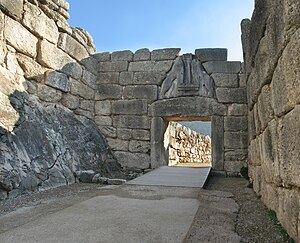සිංහ දොරටුව
| සිංහ දොරටුව | |
|---|---|
| ස්වදේශික නාමය {{lang-සැකිල්ල:ConvertAbbrev|Πύλη των Λεόντων}} | |
 | |
| පිහිටීම | මයිසීනී |
| ප්රදේශය | ආර්ගොලිඩ්, ග්රීසිය |
| නිර්මාණය වූ කාලය | ක්රි.පූ. 13වන සියවස |
| ඉදිකළ අරමුණ | බලකොටුවේ ප්රධාන පිවිසුම |
| ගෘහනිර්මාණ ශෛලීන් | සම්පිණ්ඩිත ආශ්ලේෂ බැම්ම |
සිංහ දොරටුව යනු දකුණුදිග ග්රීසියේ ලෝකඩ යුගයට අයත් මයිසීනී බලකොටු නගරය වෙත යාම සඳහා වූ ප්රධාන පිවිසුමයි. ක්රි.පූ. 13වන සියවසේ දී ඇක්රොපොලිසයේ වයඹදිග පෙදෙසේ ඉදිවූ මෙයට මෙම නම ලැබී ඇත්තේ එහි පිවිසුමට ඉහළින් ඇති පෙරමඟ දක්වන විලසින් සිටින සිංහධේනු හෝ සිංහ රූ ද්විත්වය සහිත කැටයම නිසාවෙනි.[1]
මයිසීනියානු ප්රතිමා කලාවේ නිරුපද්රිතව ඇති එකම ස්මාරක කෘතිය වන අතර,[2] ප්රාග්ඓතිහාසික ඊජියානු විශාලතම ප්රතිමාව ද වේ.[3] එසේම ග්රීක ලෝකඩ යුගයට අයත් ප්රතිමාවිද්යාත්මක මෝස්තරයක් දරන භූගත නොවූ එකම ස්මාරකය ද මෙයයි. එසේම පුරාතන සම්භාව්ය සාහිත්යයේ විස්තර වන එකම කැටයම ද මෙයයි. මේ නිසා ඒ අනුව මෙය නූතන පුරාවිද්යාවටත් පෙර සිටම ඉතා ප්රචලිතව පැවති බැව් පෙනේ.[4]
නූතන සාහිත්යය තුළ සිංහ දොරටුවේ පළමු නිරවද්ය හඳනාගැනීම සිදුවූයේ ෆැන්චෙස්කෝ ග්රිමානි විසින් සිදුකරන ලද සමීක්ෂණයක දී ය. මෙය 1700දී මොරියා රාජධානියේ ප්රෝවෙඩිටෝර් ජෙනෙරාල්ගේ නියමය අනුව සිදු විය.[5] ඔහු මයිසීනිහි නටබුන් හඳුනාගැනීමට සිංහ දොරටුව පිළිබඳ පෝසානියස්ගේ විස්තර උපයෝගී කොටගත්තේ ය.[6][7][8]
මේවාත් බලන්න
[සංස්කරණය]ආශ්රේයයන්
[සංස්කරණය]උද්ධෘත
[සංස්කරණය]- ^ Gates 2003, pp. 136–137.
- ^ Hampe & Simon 1981, p. 49: "The lions, who looked out over the land, served to protect the gate and the city. They also show that the city, and the king who ruled it, stood under the protection of the goddess Hera. The Lion relief is the sole monumental piece of Mycenaean sculpture which has come down to us."
- ^ උපුටාදැක්වීම් දෝෂය: අනීතික
<ref>ටැගය;Kleinerනමැති ආශ්රේයන් සඳහා කිසිදු පෙළක් සපයා නොතිබුණි - ^ Blakolmer 2010, පිටු අංකය: 49.
- ^ Beaudouin 1880, pp. 206–210.
- ^ Pausanias. Description of Greece, 2.16.5.
- ^ Blakolmer 2010, p. 50: "Thus it is no wonder that the Lion Gate attracted the attention of European scholars who visited this prominent city-gate in the Argolid - a region constituting not only a focal point of antiquity but also the heart-land of early modern Greece and thus presenting good preconditions for foreign travellers and scholars in the 19th century. Mycenae's first identification by a European traveller was by M. de Monceaux in 1669, while the first mention of the Lion Gate is due to the Venetian engineer Francesco Vandeyk in 1700." [Note: The interpretation of the 1669 visit is contradicted by Moore, Rowlands & Karadimas 2014 where de Monceaux had not visited Mycenae, having mistakenly identified an acropolis as Mycenae on his travels to Tiryns.]
- ^ Moore, Rowlands & Karadimas 2014, p. 4: "The first modern, correct, identification of Mycenae seems to have been made in 1700, when the government of Venice ordered Francesco Grimani, Proveditor General of the Armies in Morea, to register all their properties in the Peloponnese. The record was completed under the direction of the engineer, Francesco Vandeyk, who not only made detailed plans for each village, but also studied and described ancient monuments. Among them was the ancient site of Mycenae which he was able to identify on the basis of Pausanias' description. Vandeyk reported a monumental entrance where a triangular relief was sculpted with two lions disposed heraldically against a column. He noted that these lions stepped their forepaws on two altars and, as a result, the entrance is known today as the Lion Gate. Indeed, Pausanias' own description of the Lion Gate was so accurate that it did not leave any doubt that the monumental acropolis, close to the modem village of Charvati, was the site identified by the ancient author as Agamemnon's citadel."
ආශ්රේයයන්
[සංස්කරණය]- Beaudouin, Mondry (1880). "Fragments d'une description de l'Argolide faite en 1700 par un ingénieur italien". Bulletin de correspondance hellénique. 4: 206–210. doi:10.3406/bch.1880.4318.
{{cite journal}}: Invalid|ref=harv(help) - Blakolmer, Fritz (2010). "Images and Perceptions of the Lion Gate Relief at Mycenae during the 19th Century". In F. Buscemi (ed.). The Representation of Ancient Architecture in the XIXth Century. Cogitata. pp. 49–66.
{{cite book}}: Invalid|ref=harv(help) - Castleden, Rodney (2005). Mycenaeans. London, United Kingdom: Routledge. ISBN 978-0-415-24923-2.
{{cite book}}: Invalid|ref=harv(help) - Gates, Charles (2003). Ancient Cities: The Archaeology of Urban Life in the Ancient Near East and Egypt, Greece, and Rome. New York, New York: Routledge. ISBN 0-415-12182-5.
{{cite book}}: Invalid|ref=harv(help) - Hampe, Roland; Simon, Erika (1981). The Birth of Greek Art: From the Mycenaean to the Archaic Period. New York: Oxford University Press.
{{cite book}}: Invalid|ref=harv(help) - Iakovidis, Spyros E. (1983). Late Helladic Citadels on Mainland Greece. Leiden, The Netherlands: E. J. Brill. ISBN 90-04-06571-7.
{{cite book}}: Invalid|ref=harv(help) - Kleiner, Fred S. (2009). Gardner's Art Through the Ages: A Global History. Cengage Learning Incorporated. ISBN 0-495-11549-5.
{{cite book}}: Invalid|ref=harv(help) - Moore, Dudley; Rowlands, Edward; Karadimas, Nektarios (2014). In Search of Agamemnon: Early Travellers to Mycenae. Newcastle upon Tyne: Cambridge Scholars
Publishing. ISBN 978-1-4438-5776-5. {{cite book}}: Invalid |ref=harv (help); line feed character in |publisher= at position 20 (help)
- Mylonas, George Emmanuel (1957). Ancient Mycenae: The Capital City of Agamemnon. Princeton, NJ: Princeton University Press.
{{cite book}}: Invalid|ref=harv(help) - Mylonas, George Emmanuel (1966). Mycenae and the Mycenaean Age. Princeton, NJ: Princeton University Press.
{{cite book}}: Invalid|ref=harv(help) - O'Brien, Joan V. (1993). The Transformation of Hera: A Study of Ritual, Hero, and the Goddess in the Iliad. Lanham, Maryland: Rowman & Littlefield Publishers, Incorporated. ISBN 978-0-8476-7808-2.
{{cite book}}: Invalid|ref=harv(help) - Younger, John G. (1978). "The Mycenae-Vapheio Lion Group". American Journal of Archaeology. 82 (3). Archaeological Institute of America: 285–299. JSTOR 504459.
{{cite journal}}: Invalid|ref=harv(help)
වැඩිදුර කියවීමට
[සංස්කරණය]- Aström, P.; Blomé, B. (1964). "A Reconstruction of the Lion Gate Relief at Mycenae". Opuscula Atheniensia (OpAth). 5: 159–191.
- Blackwell, Nicholas G. (July 2014). "Making the Lion Gate Relief at Mycenae: Tool Marks and Foreign Influence". American Journal of Archaeology. 118 (3). Archaeological Institute of America: 451–488. doi:10.3764/aja.118.3.0451.
